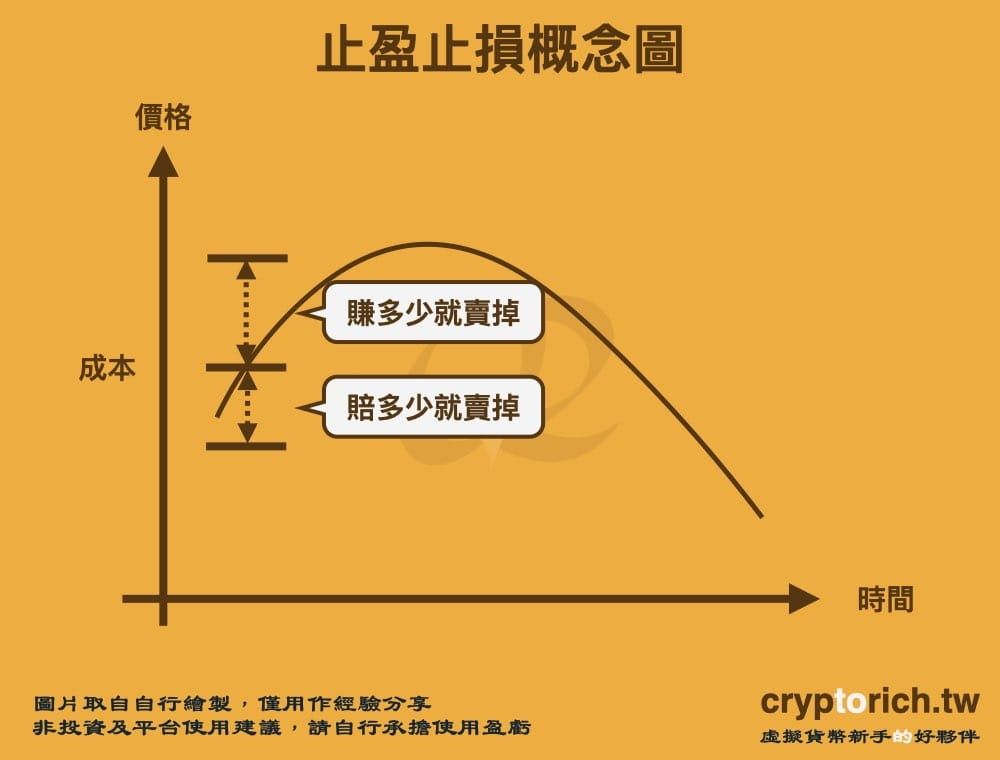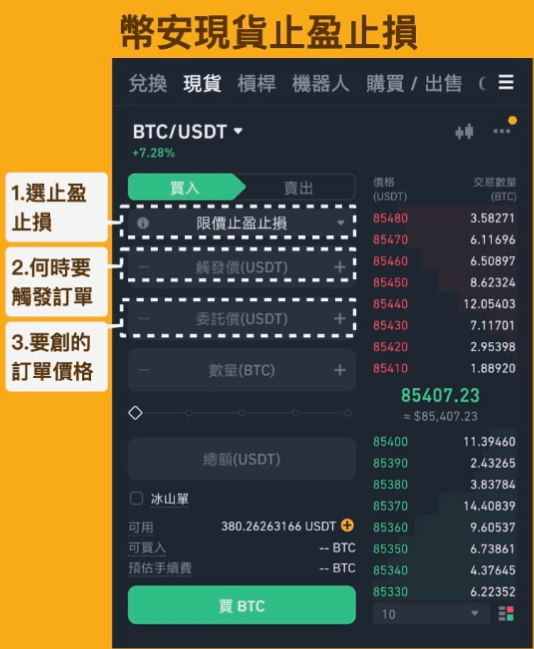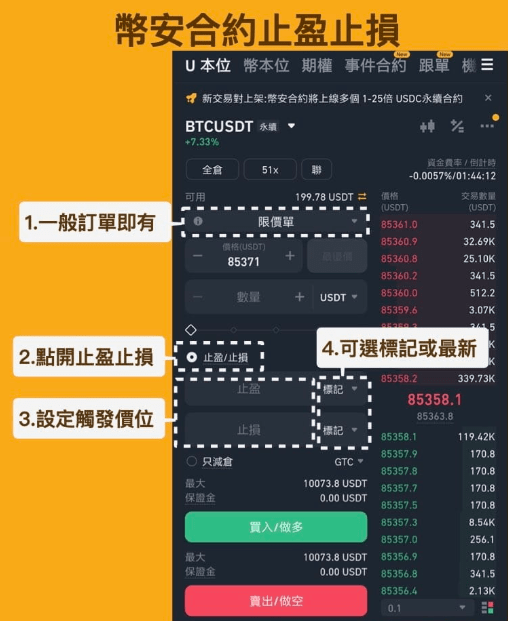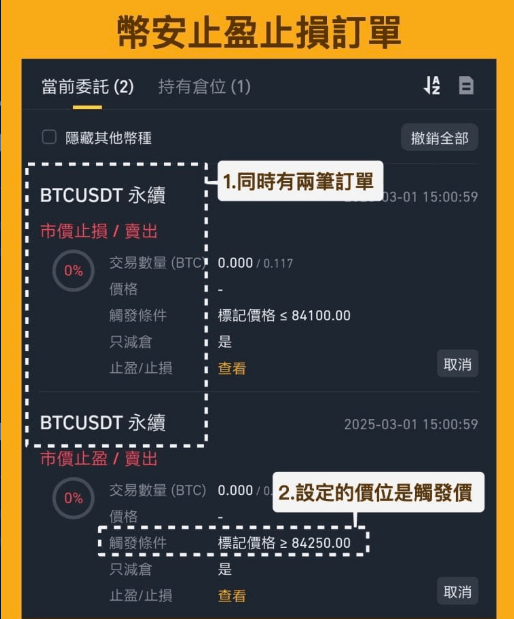Stop-loss and take-profit are one of the important strategies in cryptocurrency trading. Through stop-loss and take-profit, you can not only ensure that profits are secured or avoid losing all your capital but also evaluate whether the trading strategy is viable.
This article will introduce what stop-loss and take-profit mean, why they are necessary, and I will demonstrate related concepts and techniques with actual numbers, as well as how to use stop-loss and take-profit on Binance!
Enjoy a 20% discount on spot trading fees
Table of contents (clickable)
What does stop-loss and take-profit mean?
Why is stop-loss and take-profit necessary?
Manage risk
Stabilize your trading mindset and find a strategy.
Mastering the profit and loss ratio
The operation flow of stop-loss and take-profit
What does trailing stop-loss and take-profit mean?
How to use Binance stop-loss and take-profit?
Binance spot stop-loss and take-profit tutorial
Binance contract stop-loss and take-profit tutorial
Common questions about stop-loss and take-profit.
Summary of the key points of this article
What does stop-loss and take-profit mean?

Take-profit (Take Profit, abbreviated as TP) means putting profits in your pocket. In situations where you already have profits, you choose to sell and no longer hold, ensuring you actually make money.
Conversely, stop loss (Stop Loss, abbreviated as SL) means to cut losses. Although it is currently in a losing state, it is chosen to sell early to avoid further losses.
Usually, stop-loss and take-profit will be accompanied by specific conditions, such as taking profit when the price exceeds a certain level or stopping loss when it falls below a certain level. This specific condition is called the 'trigger price'.
As for how to set the trigger price? This depends on each investor's habits. For example, some believe that support and resistance levels are good reference points, while others believe that moving averages are.
Major trading platforms usually also provide stop-loss and take-profit functions, making it convenient for investors to set relevant price levels when placing orders, so they don't have to spend time monitoring the market to complete buy and sell trades automatically.
Why is stop-loss and take-profit necessary?
Manage risk
The primary goal of stop-loss and take-profit is to manage risk and avoid seeing cryptocurrencies rise and then fall back, or losing capital and being unable to stay in the market.
I don't know if you've experienced this: seeing the price rise and thinking it will rise more, so you hold on without selling, only to find that it falls later, turning your profits into losses.
If there was a take-profit at that time, although it might have risen more later without making a profit, at least you made some money!
Or when the price drops, unwilling to lose money and continue to hold on, only to find out that it falls even more, even losing all your capital!
If there was a stop loss at that time, although it would hurt, at least you would still have some capital returned, and you'd have the chance to stay in the market and look for the next investment opportunity.
Stabilize your trading mindset and find a strategy.
Stop-loss and take-profit can also effectively avoid the mindset affecting trading operations, which could lead to wrong decisions.
Because stop-loss and take-profit are clear numbers, once set, as soon as the price touches them, the system will automatically execute the trade for you, completely isolating human operation.
Therefore, you will no longer feel anxious about the price rising continuously, thinking you can earn more money, or not daring to sell when it drops.
In addition, after practicing stop-loss and take-profit, you can clearly know whether your strategy is effective. If it leads to losses over the long term, you should consider adjusting your strategy!
Mastering the profit and loss ratio
Experienced investors also use stop-loss and take-profit to grasp the profit and loss ratio, assessing stop-loss and take-profit prices before entering the market to decide whether it is suitable to enter.
For example, if there is an 80% chance of taking profit at a certain price level and earning 10%, and a 20% chance of stopping loss and losing 30%, since 80×10 > 20×30, it is worth entering the market.
After understanding the basic concepts of stop-loss and take-profit, let's have a look at an example.
The operation flow of stop-loss and take-profit

Assuming you bought a coin at the price of 1,000 and hope to earn 200, the take-profit price should be set at 1,200. This is quite understandable; you can even manually create a sell order at 1,200 without placing a take-profit order.
If you believe you can only afford a loss of 100, it means that if the price drops to 900, you want to sell. However, if you place a sell order at 900, it will be executed immediately since the current market price is 1,000!
At this time, this 900 must be placed on the 'stop-loss', and it may even need to be set through the 'trigger price'.
For example, if you set the trigger price to 900 and the stop loss price to 890, the system will only automatically create a sell order at 890 when the price reaches 900, so you won't execute a trade immediately at the price of 1,000!
However, if a trigger price is set, it does not guarantee that stop-loss and take-profit will be successful, because if the price does not hit the stop-loss or take-profit price after the trigger, it will still not be executed unless you choose to trade at market price.
What does trailing stop-loss and take-profit mean?
Trailing stop-loss and take-profit means not using a specific price as the stop-loss and take-profit price but deciding based on relative price levels or ratios.

For example, if a coin's price is set to trailing stop-loss at -200 when it is 1,000, the following two situations will cause differences in the stop-loss price:
The coin price first rises to 2,000: the stop-loss price becomes 1,800. When the price subsequently drops to 1,800, it will trigger the stop-loss, and although it is a stop-loss, you made a profit of 800.
The coin price drops directly to 800: trigger stop-loss.
That is, when the price moves in a favorable direction, the stop-loss price will also move accordingly, giving you a chance to earn more money and avoid being influenced by rigid numbers affecting your profits and losses.
This concept is somewhat like hedging, using flexible settings to protect existing profits. For details, you can read: What does hedging mean? How to hedge?
How to use Binance stop-loss and take-profit?
The Binance order page provides stop-loss and take-profit functions, and both spot and contract trading have them, so as long as you have a Binance account, you can trade through stop-loss and take-profit.
Enjoy a 20% discount on spot trading fees
Binance spot trading stop-loss and take-profit tutorial

Binance spot stop-loss and take-profit are similar to general order placements, except that there is an extra trigger price, and they are divided into market stop-loss and take-profit and limit stop-loss and take-profit.
The meaning of Binance trigger price is that when the market reaches this price, it will trigger the market or limit order you set, similar to the concept of a switch.
The market price is executed at the market price immediately, while the limit price is executed only when it reaches the specified price.
Further reading:
Binance buying tutorial, guiding you to buy your first cryptocurrency.
What are market price and limit price? What is the difference? How to choose?
Binance contract stop-loss and take-profit tutorial.

Binance contract stop-loss and take-profit can be set when creating a position, which means you can set the buy and sell conditions at once, and when the price reaches, it will automatically buy and sell, saving time from manually taking profit and stopping loss after waiting for execution.
However, be aware that the stop-loss and take-profit prices set here refer to the 'trigger price.' After reaching the set price, it will place an order at market price.
Additionally, you will see options for marked price and latest price, which indicate which price the trigger price should refer to:
Marked price: The price derived from combining the same assets across major exchanges after calculation.
Latest Price: The latest transaction price in the Binance contract market.
Generally speaking, if the position risk is controlled well and won't lead to liquidation easily, it is recommended to use the marked price so that you won't accidentally trigger stop-loss and take-profit.

If the created order has been executed, the system will simultaneously create an order at the stop-loss and take-profit price, so you will see two orders in 'current orders.' As soon as one is triggered, the other will automatically close!
Further reading: What is a cryptocurrency contract? Taking Binance contracts as an example.
If you want to further clarify how stop-loss and take-profit work, you can also practice with simulated trading. Through simulated trading, you can place orders at zero cost to see what happens:
Binance simulated trading tutorial! Zero risk can also trade contracts.
Common questions about stop-loss and take-profit.
Is the trigger price for stop-loss and take-profit the execution price?
No, the trigger price means triggering the stop-loss and take-profit orders. At this time, these orders will appear in the market, and the trading price of these orders may differ from the trigger price, and even at market price, there may be differences due to market fluctuations.
How to set the ratio for stop-loss and take-profit?
Many people use support and resistance levels, Bollinger Bands, etc., as relevant criteria, but everyone's tolerance for profit and loss is different. Therefore, it is suggested that take-profit can be set at 'the amount of profit that makes you satisfied', while stop-loss is 'the amount of loss that makes you feel pain'.
Summary of the key points of this article
Finally, here are the key points summarizing stop-loss and take-profit:
Take-profit means cashing out at a specified price level, even if it rises more later, that's okay.
Stop-loss means to cut losses and ensure a certain level of capital is returned.
Through stop-loss and take-profit, you can manage capital risk and stabilize your trading mindset.
Moving stop-loss and take-profit can track market fluctuations and flexibly adjust trading strategies.



